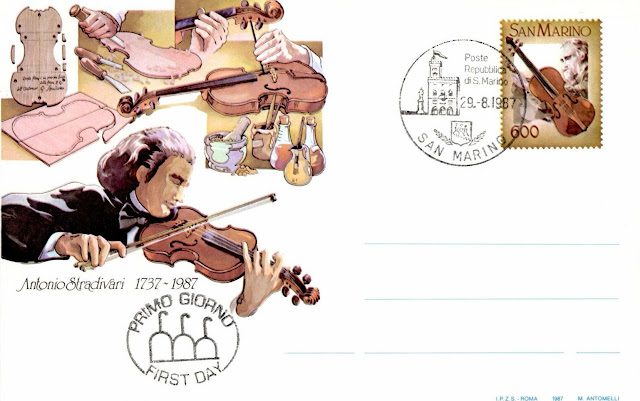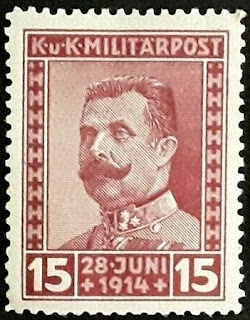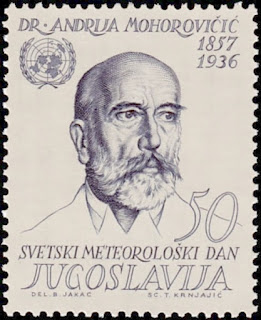1737 Died: Antonio Stradivari, Italian instrument maker (b. 1644)
Antonio Stradivari (1644 – 18 December 1737) was an Italian luthier and a crafter of string instruments such as violins, cellos, guitars, violas, and harps. The Latinized form of his surname, Stradivarius, as well as the colloquial Strad are terms often used to refer to his instruments. It is estimated that Stradivari produced 1,116 instruments, 960 of which were violins. Around 650 instruments survived, including 450 to 512 violins.
1863 Born: Archduke Franz Ferdinand of Austria (d. 1914)
Archduke Franz Ferdinand Carl Ludwig Joseph Maria of Austria (18 December 1863 – 28 June 1914) was the heir presumptive to the throne of Austria-Hungary. His assassination in Sarajevo precipitated Austria-Hungary's declaration of war against Serbia, which in turn triggered a series of events that eventually led to Austria-Hungary's allies and Serbia's declaring war on each other, starting World War I.
Bosnian stamps issued in 1917 depicting Franz Ferdinand
1878 Born: Joseph Stalin, Georgian-Russian marshal and politician, 4th Premier of the Soviet Union (d. 1953)
Joseph Vissarionovich Stalin (18 December 1878 – 5 March 1953) was a Georgian revolutionary and Soviet politician who led the Soviet Union from the mid–1920s until 1953 as the general secretary of the Communist Party of the Soviet Union (1922–1952) and premier of the Soviet Union (1941–1953). Despite initially governing the Soviet Union as part of a collective leadership, he eventually consolidated power to become the country's de facto dictator by the 1930s. A communist ideologically committed to the Leninist interpretation of Marxism, Stalin formalised these ideas as Marxism–Leninism, while his own policies are known as Stalinism.
Born to a poor family in Gori in the Russian Empire (now Georgia), Stalin joined the Marxist Russian Social Democratic Labour Party as a youth. He edited the party's newspaper, Pravda, and raised funds for Vladimir Lenin's Bolshevik faction via robberies, kidnappings, and protection rackets. Repeatedly arrested, he underwent several internal exiles. After the Bolsheviks seized power during the 1917 October Revolution and created a one-party state under Lenin's newly renamed Communist Party, Stalin joined its governing Politburo. Serving in the Russian Civil War before overseeing the Soviet Union's establishment in 1922, Stalin assumed leadership over the country following Lenin's 1924 death. Under Stalin, "Socialism in One Country" became a central tenet of the party's dogma. Through the Five-Year Plans, the country underwent agricultural collectivisation and rapid industrialisation, creating a centralised command economy. This led to significant disruptions in food production that contributed to the famine of 1932–33. To eradicate accused "enemies of the working class", Stalin instituted the "Great Purge", in which over a million were imprisoned and at least 700,000 executed between 1934 and 1939. By 1937, he had complete personal control over the party and state.
Stalin's government promoted Marxism–Leninism abroad through the Communist International and supported European anti-fascist movements during the 1930s, particularly in the Spanish Civil War. In 1939, it signed a non-aggression pact with Nazi Germany, resulting in the Soviet invasion of Poland. Germany ended the pact by invading the Soviet Union in 1941. Despite initial setbacks, the Soviet Red Army repelled the German incursion and captured Berlin in 1945, ending World War II in Europe. The Soviets annexed the Baltic states and helped establish Soviet-aligned governments throughout Central and Eastern Europe, China, and North Korea. The Soviet Union and the United States emerged from the war as global superpowers. Tensions arose between the Soviet-backed Eastern Bloc and U.S.-backed Western Bloc which became known as the Cold War. Stalin led his country through the post-war reconstruction, during which it developed a nuclear weapon in 1949. In these years, the country experienced another major famine and an anti-semitic campaign peaking in the doctors' plot. After Stalin's death in 1953 he was eventually succeeded by Nikita Khrushchev, who denounced his predecessor and initiated the de-Stalinisation of Soviet society.
Widely considered one of the 20th century's most significant figures, Stalin was the subject of a pervasive personality cult within the international Marxist–Leninist movement which revered him as a champion of the working class and socialism. Since the dissolution of the Soviet Union in 1991, Stalin has retained popularity in Russia and Georgia as a victorious wartime leader who established the Soviet Union as a major world power. Conversely, his totalitarian government has been widely condemned for overseeing mass repressions, ethnic cleansing, deportations, hundreds of thousands of executions, and famines which killed millions.
Stamps from Russia and China depicting Stalin
1913 Born: Willy Brandt, German politician, 4th Chancellor of Germany, Nobel Prize laureate (d. 1992)
Willy Brandt (18 December 1913 – 8 October 1992) was a German statesman who was leader of the Social Democratic Party of Germany (SPD) from 1964 to 1987 and served as Chancellor of the Federal Republic of Germany (West Germany) from 1969 to 1974. He was awarded the Nobel Peace Prize in 1971 for his efforts to strengthen cooperation in western Europe through the EEC and to achieve reconciliation between West Germany and the countries of Eastern Europe. He was the first Social Democrat chancellor since 1930.
Fleeing to Norway and then Sweden during the Nazi regime and working as a left-wing journalist, he took the name Willy Brandt as a pseudonym to avoid detection by Nazi agents, and then formally adopted the name in 1948. Brandt was originally considered one of the leaders of the right wing of the SPD, and earned initial fame as Governing Mayor of West Berlin. He served as Foreign Minister and as Vice Chancellor in Kurt Georg Kiesinger's cabinet, and became chancellor in 1969. As chancellor, he maintained West Germany's close alignment with the United States and focused on strengthening European integration in western Europe, while launching the new policy of Ostpolitik aimed at improving relations with Eastern Europe. Brandt was controversial on both the right wing, for his Ostpolitik, and on the left wing, for his support of American policies, including the Vietnam War, and right-wing authoritarian regimes. The Brandt Report became a recognised measure for describing the general North-South divide in world economics and politics between an affluent North and a poor South. Brandt was also known for his fierce anti-communist policies at the domestic level, culminating in the Radikalenerlass (Anti-Radical Decree) in 1972.
Brandt resigned as chancellor in 1974, after Günter Guillaume, one of his closest aides, was exposed as an agent of the Stasi, the East German secret service.
German stamps depicting Willy Brandt
1936 Died: Andrija Mohorovičić, Croatian meteorologist and seismologist (b. 1857)
Andrija Mohorovičić (23 January 1857 – 18 December 1936) was a Croatian meteorologist and seismologist. He is best known for the eponymous Mohorovičić discontinuity and is considered as one of the founders of modern seismology.
On 8 October 1909 there was an earthquake with its epicentre in the Pokuplje region, 39 km southeast of Zagreb. A number of seismographs had been installed beforehand and these provided invaluable data, upon which he made new discoveries. He concluded that when seismic waves strike the boundary between different types of material, they are reflected and refracted, just as light is when striking a prism, and that when earthquakes occur, two waves—longitudinal and transverse—propagate through the soil with different velocities. By analyzing data from more observation posts, Mohorovičić concluded that the Earth has several layers above a core. He was the first to establish, based on the evidence from seismic waves, the discontinuity that separates the Earth's crust from its mantle. This is now called the Mohorovičić discontinuity or (because of the complexity of that name) Moho. According to Mohorovičić, a layered structure would explain the observation of depths where seismic waves change speed and the difference in chemical composition between rocks from the crust and those from the mantle. From the data, he estimated the thickness of the upper layer (crust) to be 54 km. We know today that the crust is 5–9 km below the ocean floor and 25–60 km below the continents, which are carried on tectonic plates. Subsequent study of the Earth's interior confirmed the existence of the discontinuity under all continents and oceans.
Mohorovičić assumed that the velocity of seismic waves increases with the depth. The function he proposed to calculate the velocity of seismic waves is called the Mohorovičić law. He developed a method for determining earthquake epicenters and constructed curves giving the travel times of seismic waves over distances of up to 10,000 miles from the source. He also proposed the construction of a new type of seismograph for recording the ground horizontal movement, but due to lack of funds the project was never realized.
As early as 1909 Mohorovičić started giving lectures that both architects and building contractors should follow, ahead of his time setting some of the basic principles of earthquake-resistant design. Mohorovičić's theories were visionary and were only truly understood many years later from detailed observations of the effects of earthquakes on buildings, deep focus earthquakes, locating earthquake epicenters, Earth models, seismographs, harnessing the energy of the wind, hail defence and other related elements of the geological body of knowledge known as geoscience.
Yugoslavian stamp depicting Mohorovičić











No comments:
Post a Comment